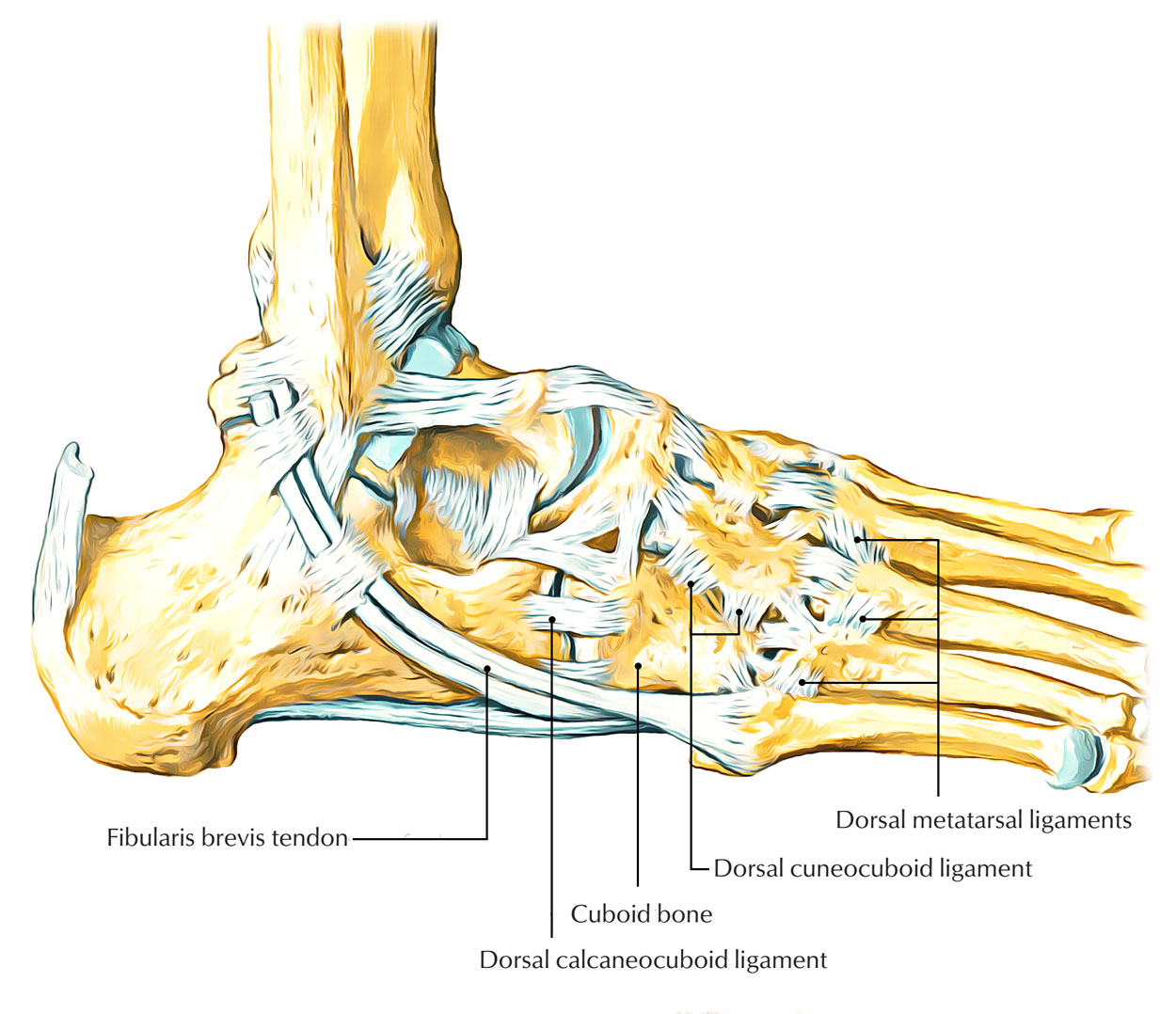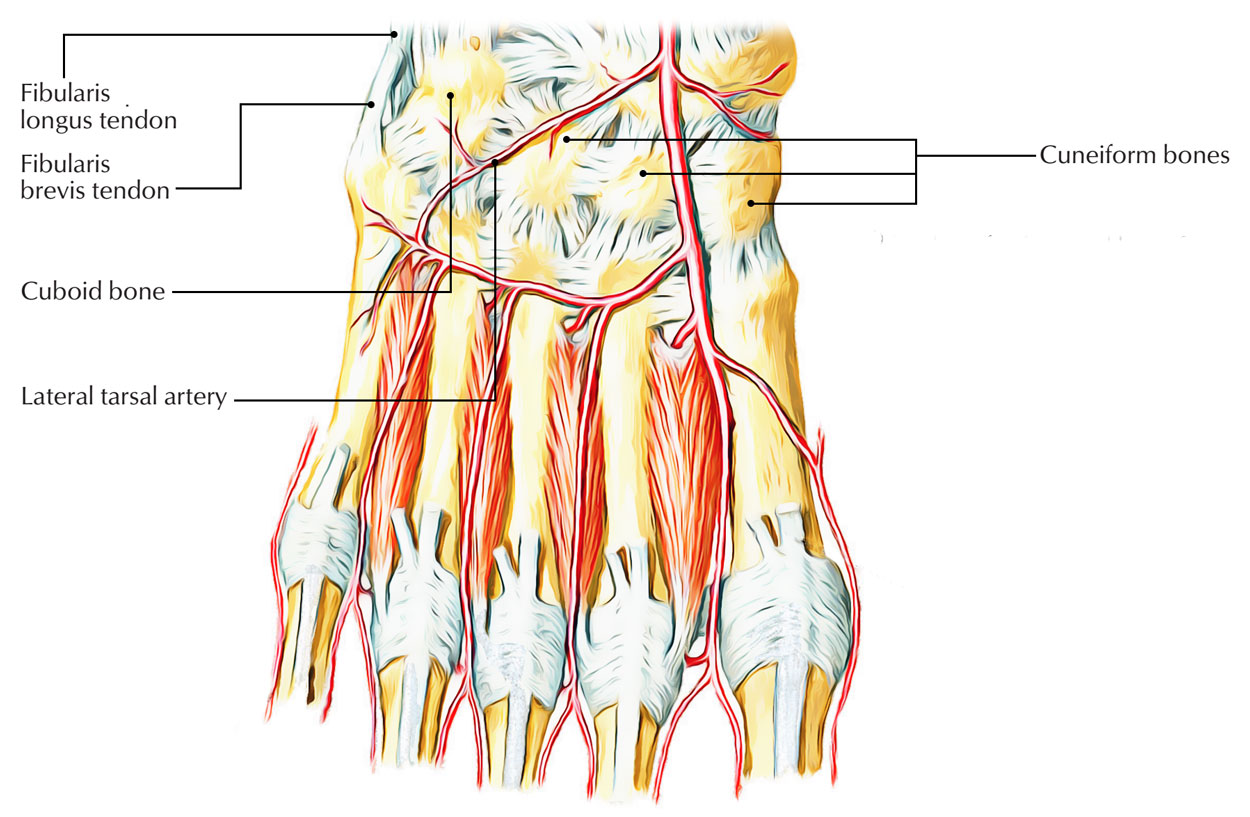Cuboid bone is among the seven tarsal bones of the foot. The cuboid bone as the name suggests is cuboid fit. It is positioned in front of calcaneum and also behind the fourth as well as fifth metatarsals.

cuboid bone
Surfaces
It provides 6 sides: anterior, posterior, dorsal, plantar, medial, and lateral:
- Anterior (distal) side provides medial quadrangular along with lateral triangular articular sides, which integrate with the bases of fourth as well as fifth metatarsals, respectively.
- Posterior (proximal) side provides a concavo-convex integrate side (saddle-shaped articular side) for connection with the anterior side of the calcaneum.
- Dorsal (superior) side is rough as well as flat. It is pointed up as well as laterally, and also supplies connection to dorsal ligaments of the foot.
- Plantar (inferior) side provides an oblique depression in its distal part for the transmission of tendon of peroneus longus.
- Medial side provides two articular sides– a large distal oval side as well as a small proximal oval side which integrate with the navicular along with lateral cuneiform bones, respectively.
- Lateral side is small and grooved by the tendon of peroneus longus.
Connections
- At the ridge on the plantar side: Long plantar ligament
- Proximally it is connected to the base of the calcaneus along with distally to the bases of the 3rd, Fourth and Fifth metatarsals.
- The groove in front of the ridge is consequently transformed in a tunnel for the transmission of the peroneus longus tendon going to be placed into plantar sides of medial cuneiform as well as base of the First metatarsal.
- At the region posterior the ridge:
- Short plantar ligament.
- Origin of the flexor hallucis brevis
- Attachment of a slip of tibialis posterior.
- At the dorsal side:
- Dorsal calcaneocuboid
- Cubonavicular
- Cuneocuboid
- Cubo-metatarsal ligaments
- At the medial side:
- Interosseous cuneocuboid.
- Cubonavicular ligaments.
- Lateral band of the bifurcated ligament
Ossification
From primary centre starts to ossify at the 9th month of the foetal life
Arterial Supply

Cuboid Bone – Arterial Supply
Arterial supply is through the lateral tarsal artery, a branch of the dorsalis pedis.
Clinical Significance
Cuboid Fractures
Cuboid fractures seldom happen in isolation and have actually been reported in conjunction with:
- ( 1) TMT fracture dislocations,
- ( 2) Subtalar fracture-dislocation,
- ( 3) Type 3 navicular fractures, and
- ( 4) Choparfs fracture-dislocations.
Midfoot Injuries
- Midfoot injuries ought to trigger close evaluation of the cuboid. Cuboid fractures might be subtle and arc finest imagined on the oblique view of the foot.
- CT scan offers great information of even subtle midfoot fractures that might show helpful in preoperative preparation.
- As is the ease for the pelvic ring, it is essentially impossible to break the midfoot in a single location.
- The lateral and medial columns of the foot function in concert, and a separated compression injury to the lateral column of the foot is not likely without a matching disturbance of the medial column.
The nutcracker fracture
- The nutcracker fracture of the cuboid arise from required plantar flexion and abduction of the foot that compresses the cuboid in between the calcaneus and fourth and fifth metatarsals. A comparable system for cuboid fracture might be observed with Chopart’s dislocations, subtalar fracture-dislocarions, and lateral peritalar dislocations.
- If the resultant reducing of the foot’s lateral column and articular disturbances arc left without treatment, patients establish a symptomatic pes planus defect and arthrosis of the CC and fourth and fifth TMT joints.
- Additionally, forefoot plantar flexion and abduction triggers marginal impaction injuries to the articular sides of the fourth and fifth metatarsals, leading to arthrosis without reducing associated lateral column .
- Required forefoot adduction injuries might trigger cuboid avulsion fractures that tend not to develop the longterm sequelae explained for compressive cuboid injuries.

 (57 votes, average: 4.90 out of 5)
(57 votes, average: 4.90 out of 5)